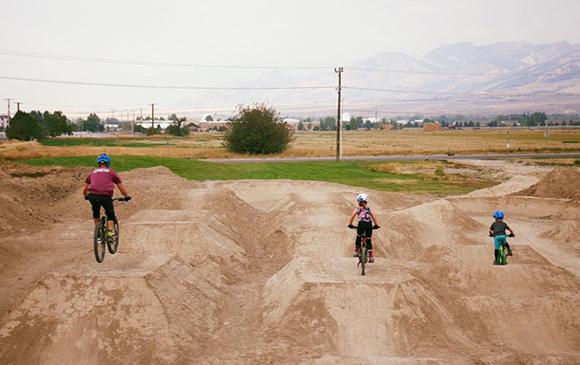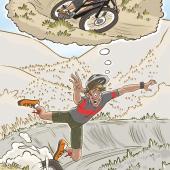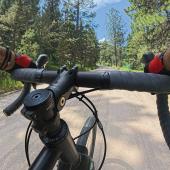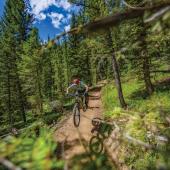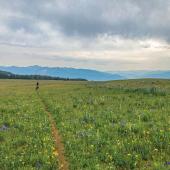Crankin' Good Fun, Dirt Cheap
All about Gallatin Valley BMX and the Westlake BMX Park.
We drove past the bicycle motocross (BMX) track on the way to the grocery store. I saw mounds of dirt, choking summer dust, and a white, paint-chipped shack overlooking what I assumed to be a few trouble-making boys who had nothing better to do than endlessly cruise the track on their bikes. My oldest son, Dylan, then six years old, saw something different. “Hey, mom, pull over please, I want to watch these guys.”
His eyes grew wide when one of the riders popped into the air like ejected toast, clearing the double jump before landing and then rounding a tight curve. Wow. They made it look easy. Maybe it was easy.
The next week Dylan and I took our bikes to the track, him on a heavy little red Diamondback with knobby tires, me on a Kona mountain bike. We perched up at the starting gate, which was higher than it appeared from the car. Dylan took off without looking back. I coasted down cautiously, my hand ready at the brakes, feeling as uncertain as a nun on a Harley. By the time I made it around the track, surviving the 1,000 feet of step-ups, double jumps, berms, triple jumps and the rhythm section, I was further humbled—and not at all convinced this was a safe sport for my six-year-old.
He begged me to take him to a race. The energy at a Gallatin Valley BMX race is electric, even for a mom who is trying to diplomatically talk the sparkle out of her son’s eyes. Riders are grouped into “motos” which are based on age and ability (novice, intermediate, expert). When track director and announcer Kelly Stowell calls a moto into the gate, up to eight riders push their bikes into their assigned lanes, clip shoes into pedals, lift their uniform-clad butts off the seat, and wait for the green light to signal the gate drop.
Stowell is famous for his humorous announcing skills, as well as taking the time to know each rider, which is reflected in the unique racing names he gives each of them. There’s the “Flying Irishman” from Butte America, “Elvis” because he’s always well groomed and the ladies love him, Wrong-way Levi, Trash-talking Toni, Fuzzy, and D-Fresh, to name a few.
“Okay riders, set them up…. Riders ready, watch the light.” The gate released with a crash and hips snapped forward toward handlebars, gravity and a blur of scissoring legs took them down the first hill at impressive speeds.
“Mom, I want to do this,” my son pleaded that first warm evening. After bribing and hauling him to piano and several rounds of swim lessons, how could I squelch such passion?
Now, four years later, I’m glad I didn’t. Since my first introduction to BMX, I’ve learned that the “troublemakers” riding the track encompass riders from two year olds (no lie) to fifty-somethings, whole families who race, including boys, girls, moms, dads, MSU professors, realtors from Big Sky, plumbers, physicians, and even Evil Knievel’s grandkids. The teenagers I saw riding that first day are the same boys who later held Dylan’s seat for him in the starting gate until he learned to balance on his own and have helped change or repair countless popped bike tubes. They make BMX riding look easy because when they’re not at the track in the summer they’re usually traveling to state qualifiers and even national races, dreaming of someday exchanging their “expert” title for “Pro.”
Because BMX racing is about speed and making it to the finish line as fast as you can rather than catching big air (though some of the riders are so accomplished they manage both), it is a separate sport than Freestyle, where riders use BMX bikes to perform tricks. If you’ve driven by the track recently you’ve probably noticed some changes. A freestyle section is being sculpted in next to the racetrack so riders can practice both disciplines, and the City’s master plan for the park includes the eventual addition of picnic tables and a playground.
While some people spend a lot of money on ultra-light bike components and other high-tech racing gear, the only things needed to BMX race is an American Bicycle Association (ABA) temporary or year-long membership, five dollars per race, a bike, long pants, a long-sleeved shirt, and a helmet. A full-face helmet provides better protection than a traditional bike helmet, but isn’t required.
As expected, Dylan has collected a few noteworthy bruises and scrapes over the years, but nothing requiring more than a Band-Aid, sympathy, and a little time. Nothing that has extinguished the sparkle from his eyes for this adrenaline sport. These days I drive him to other Montana dirt piles on summer weekends, like a BMX gypsy mom who’s glad she pulled over to see what was really crankin.’

